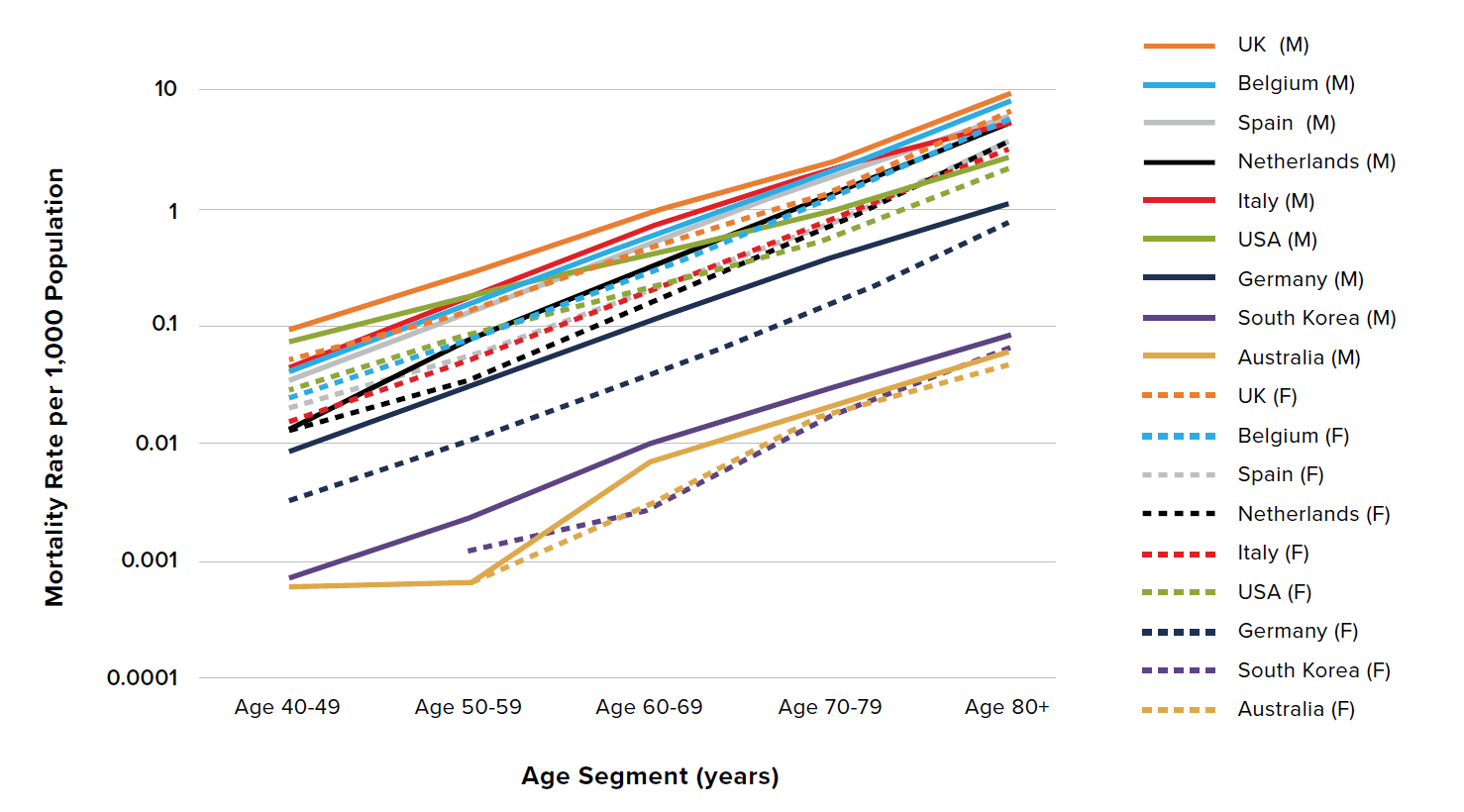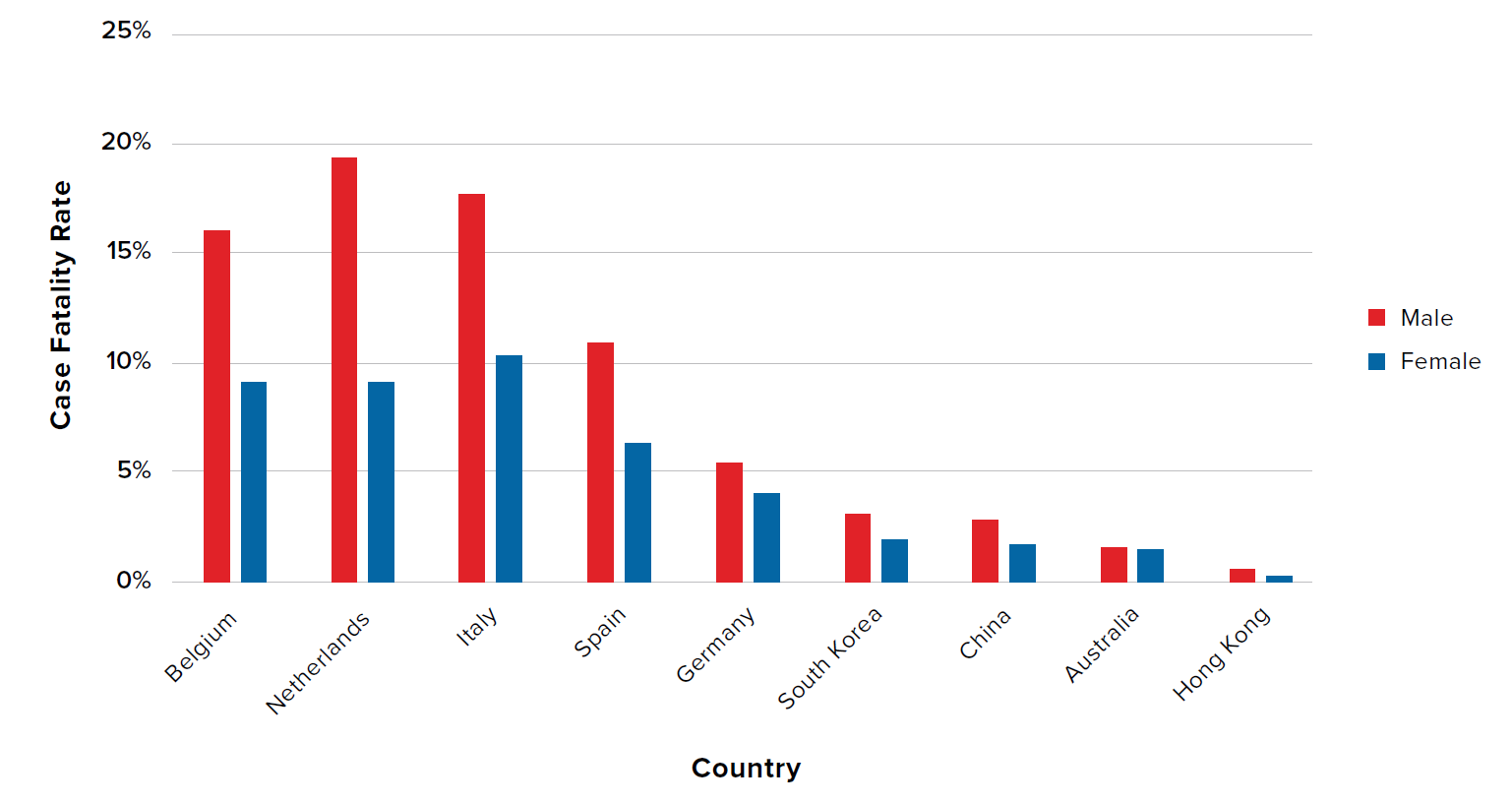Recent correspondence published in The Lancet Global Health emphasized that better data are needed to give a clear understanding of the differences in estimates of COVID-19’s lethality.
Age- and sex-disaggregated COVID-19 case fatality data are essential to understanding the impact COVID-19 will have in different subpopulations, yet some countries do not report the data by these stratifications. Even in countries that do report COVID-19 cases and deaths by age, the age stratifications are often very different. In this article, RGA’s Global Data and Analytics team highlights publicly available COVID-19 case fatality data by age and sex, discussing some of the limitations of the data as well as the insights from it.
Measuring the lethality of COVID-19
To measure the scale and impact of the COVID-19 pandemic, it is essential to know how many people have been infected with the SARS-CoV-2 virus causing the disease (the infection rate, or attack rate) as well as the number of infected people who have died as a result of the disease (the infection fatality rate). Neither the attack rate nor the infection fatality rate can be calculated directly from case fatality data so they need to be estimated, usually as part of an epidemiological model, with different models producing different estimates.
In contrast, the case fatality rate (CFR) of COVID-19 can be calculated directly from the available case fatality data. This objectivity and ease of calculation has led to the CFR being widely reported in media outlets and scientific articles. However, during a pandemic, especially one about which there are many uncertainties, it is important to recognize that case fatality rates do not reflect the true risk of dying with COVID-19, which is actually captured by the infection fatality rate.
Together, the infection rate and infection fatality rate will tell us about COVID-19’s cause-specific mortality rate. The mortality rate is of key interest to life insurers, but, at this stage of the pandemic, there is still significant uncertainty regarding country-specific estimates of this figure. What is evident from COVID-19 case fatality data published to date, however, is that the case fatality rate is highly dependent on age. The evidence so far also suggests that, among confirmed cases, men around the world are consistently dying at a higher rate.
Before analyzing case fatality data and interpreting case fatality rates, it is important to note some of the significant limitations surrounding data on COVID-19 cases and deaths. In different countries – and even within a country – practices differ as to what is counted as a COVID-19 death. For example, COVID-19 mortality figures might include:
Only deaths that occur in hospitals (and not other locations such as care homes)
Only a proportion of deaths because of delays in reporting
Only deaths where testing, which is often limited, confirmed individuals were infected with the causative virus (rather than possible/probable COVID-19 infections)
Only deaths where COVID-19 was determined to be a contributory cause of death (individuals were deemed to have died from COVID-19 as opposed to have died with COVID-19)
Uncertainty in case fatality rates also derives from uncertainty in the number of cases. The number of tests conducted in a given country affects its overall CFR because a person must be tested in order to confirm that he or she is infected with the virus. Many countries have conducted only very limited COVID-19 testing, so we do not yet have a good understanding of the total number of cases of the disease in many locations (i.e., the attack rate).
Consequently, while we may observe huge disparities in the CFR across countries, we need to be very cautious about making inferences because the CFRs may reflect the magnitude of a country’s testing strategies rather than the true risk of dying after infection there. To read more on these limitations, a good discussion can be found here. Regardless, CFRs are a valuable data component to be utilized and can help us to tease out potentially important differences in experience to date.
Population-level COVID-19 case fatality data by age and sex
Population-level estimates of COVID-19’s CFR by country are somewhat useful for understanding the average severity of the pandemic, but this statistic does not tell us who, within a population, is at greatest risk of dying from the disease. Understanding the relative risk to different sections of a population allows policymakers to focus on the most vulnerable and improve the allocation of health resources to those who need them most.
Table 1 in the case fatality data section at the end of this document for a list of sources available at the time this article was written.
Significant insights can be gained from case fatality data by age and gender and these will be explored and shared in future research articles. As an illustration, life insurers will be interested in the lethality of COVID-19 by age and gender, which they can use as a starting point to estimate the impact the pandemic may have on their portfolio of insureds. Figure 1 plots COVID-19’s CFR by gender for select countries, and Figure 2 shows mortality rates (on a log scale) by age and gender for select countries.
Figure 1:
Figure 2:
Estimates of COVID-19’s mortality rate per 1,000 population on the log scale by age, gender, and country in adults aged 40 years and older. Using data available as of 20th May 2020.

Note: Some data have been smoothed in order to show consistent age segments.
Australia (F)
Although these countries are at different stages of the pandemic (with markedly different infection rates and total deaths), we observe quite similar patterns in the increase of mortality by gender (Figure 1) and by age and gender (Figure 2).
Applying insights to the insured population
The different levels of mortality seen by age, gender, and country at this point in the pandemic will also reflect differences in population health, lifestyle behaviors, and sociodemographic factors, as well as government policy and healthcare capacity issues. Insurers will need to make appropriate adjustments for these factors before using these mortality rates to their insured books.
In addition, insurers will need to anticipate how the mortality rate will change as the pandemic progresses and how factors such as mitigation measures, government policies, exit strategies, economic strains, and so on will affect their insured portfolios. We can also expect to see a number of ‘ripple effects’ that may not be immediately obvious.
Some of these questions will be explored in future research articles.
COVID-19 case fatality data
Table 1:
COVID-19 case fatality data by age and gender, including links to data sources
Country | Cases by age | Cases by gender | Cases by age and gender | Deaths by age | Deaths by gender | Deaths by age and gender |
|---|
Australia | Yes | Yes | Yes | Yes | Yes | Yes |
Belgium | Yes | Yes | Yes | Yes | Yes | Yes |
China | Yes | Yes | - | Yes | Yes | - |
Germany | Yes | Yes | Yes | Yes | Yes | Yes |
Italy | Yes | Yes | Yes | Yes | Yes | Yes |
Netherlands | Yes | Yes | - | Yes | Yes | Yes |
South Korea | Yes | Yes | Yes | Yes | Yes | Yes |
Spain | Yes | Yes | Yes | Yes | Yes | Yes |
U.K. | - | - | - | Yes | Yes | Yes |
U.S. | Yes | - | - | Yes | Yes | Yes |








